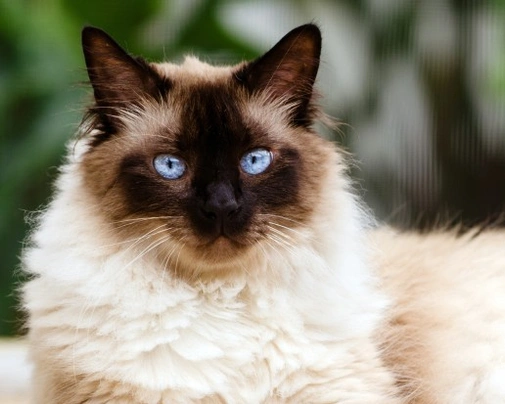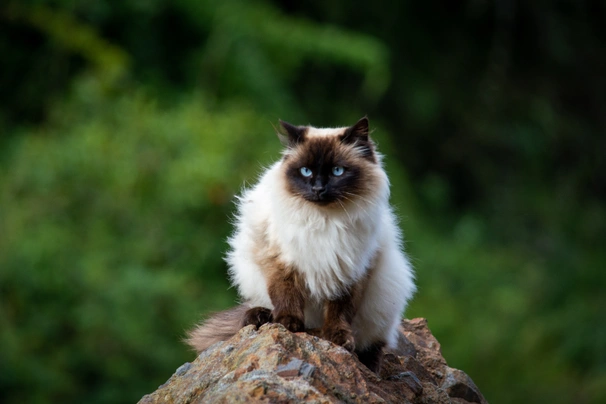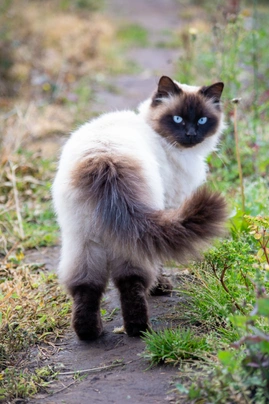Himalayan
Introduction of the Himalayan
The Himalayan is a very beautiful medium to large sized cat that boasts having the coat of a Persian but the colouring and gorgeous blue eyes of a Siamese. Over the years they have found their way into the hearts and homes of cat lovers the world over which includes the UK not only because they are so stunning to look at but also because they boast having such sweet kind and affectionate natures. However their numbers remain quite low in the UK although steadily rising. As such anyone wishing to share their homes with a Himalayan would need to register their interest with breeders for the pleasure of doing so.
History of the Himalayan
The Himalayan is a relative new comer to the cat world having been first developed during the early thirties by breeders in the United States before being further developed by breeders both in the United Kingdom and Canada. It was only in the fifties that the longhair version of the Himalayan was developed gaining recognition from the GCCF in 1955 when they were called Colourpoint Longhairs.
The major contributor in the development of the breed in the United States was a lady called Marguerita Goforth who set about creating a Persian type breed that boasted having the markings and points of the Siamese. These attractive cats were finally awarded championship status by American breed associations in 1957 at which time the breed became known as the Himalayan.
Today the Himalayan remains a popular breed in the United States and their popularity is growing in other countries of the world including the United Kingdom although for the moment the breed is not recognised by the GCCF. However anyone wishing to share a home with a Himalayan would need to register their interest with breeders because few well-bred kittens become available every year.
Appearance of the Himalayan
The Himalayan is a very attractive medium to large sized cat that boasts having quite a short cobby look about them. They have lovely round domed broad heads with a nice breadth to them but which are nicely in proportion with the rest of a cat’s body. They have powerful broad jaws with perfect teeth and their cheeks are prominent and full which adds to a Himalayan's endearing sweet looks.
They have small ears which are rounded at the tips and not that open at the base being set nicely apart and in line with the contour of a cat's head. Their eyes are rounded in shape and large being full and set nicely apart on a cat's face. The colour of a cat's eyes is just as important as their shape and they can be blue copper or green. Chins are full well developed and strong with cats having noses which are nearly as broad as they are long. Nostrils are nicely open and muzzles short full and broad. When seen in profile a Himalayan has a short snub nose with a well-defined break between their eyes. Their foreheads noses and chins are in a straight line and necks are thick well -muscled and short.
The Himalayan boasts having quite a cobby medium to large sized body that's firm and well-rounded around their mid sections. Their backs are level and short with cats having deep chests. Shoulders and rumps boast being well rounded and their legs show a good amount of bone being well developed and muscular. They have large round feet and their tails are straight and short being nicely in proportion with the rest of a cat's body.
When it comes to their coat the Himalayan can either have long hair all over their bodies or short coats. Longhaired cats have a dense undercoat which adds to the voluminous look of their coats and they have full ruffs around their necks. However short haired Himalayans have slightly longer hair than other shorthair breeds. Their hair is soft plush and dense standing well away from the body. Coat colours should be clean with subtle shadings with more mature cats having darker shading on their points which includes on their ears legs feet tail and mask. Their colouring can be as follows:
- Chocolate
- Seal
- Lilac
- Blue
- Black
- Flame
- Red
- Cream
- Tortoiseshell
- Frost
- Silver
- Golden
- Brown
- Fawn
- Cinnamon
Temperament of the Himalayan
Like other breeds the Himalayan likes a routine and doesn't particularly like it when this changes for any reason. They like to be fed at the same time of the day and don't appreciate it when furniture gets moved around the home which can often stress cats out. With this said they are known to be one of the sweetest natured breeds around. They are easy going much preferring to keep their feet on the ground rather than climb up curtains. Although not the most energetic of cats the Himalayan adores playing interactive games whether it's chasing a rolled-up bit of paper or an expensive good quality toy across the room.
Himalayans are extremely sensitive to their owner’s feelings and moods. They form strong bonds with their families and being highly intelligent they learn new things quickly and are always ready to hold a quiet conversation when they are spoken to. With this said they are not as demanding as other breeds which is one of the reasons why they make such wonderful family pets and companions.
Intelligence / Trainability of the Himalayan
Himalayans are known to be smart cats but being so laid back and easy going means they take their time about things preferring to contemplate whether anything is worth doing or not. They are just as happy to be with their owners curled up next them as they are playing interactive games.
Children and other
Himalayans are a good choice for families where the children are older and who therefore know how to behave around cats. With this said any interaction between younger children and Himalayans should always be well supervised by an adult to make sure things stay nice and calm. With this said children need to be taught how to behave around cats and when it's time to leave them alone.
They also get on well with dogs especially if they have grown up together in the same household. However care has to be taken when introducing a Himalayan to dogs they don't already know just in case the dog does not get on with their feline counterparts. They are social by nature and have been known to get on with pet birds and small animals but it's always wiser to keep a close eye on any cat when they are around smaller pets particularly when they first meet each other just to be on the safe side.
Health of the Himalayan
The average life expectancy of a Himalayan is between 10 and 15 years when properly cared for and fed an appropriate good quality diet to suit their ages.
The Himalayan is known to suffer from a few hereditary health issues which are worth knowing about if you are planning share your home with one of these beautiful cats. The conditions that seem to affect the breed the most include the following:
- Polycystic kidney disease (PKD) - breeders should have stud cats tested
- Breathing issues and sensitivity to heat
- Sensitive skin (Feline hyperesthesia)
Caring for the Himalayan
As with other breeds Himalayans need to be groomed on a regular basis to make sure their coats and skin are kept in top condition. On top of this cats need to be fed good quality food that meets all their nutritional needs throughout their lives which is especially true of kittens and older cats.
Grooming of the Himalayan
Himalayans can boast having shorter close lying coats which are lower maintenance on the grooming front than longer haired Himalayans. A weekly brush and wipe over with a chamois leather is all it takes to keep their coats in good condition with a nice sheen on it. Longhaired cats need to be brushed more often to prevent knots and tangles from forming in their coats and like other breeds they tend to shed the most in the Spring and then again in the Autumn when more frequent brushing is usually necessary to keep on top of things.
It's also important to check a cat's ears on a regular basis and to clean them when necessary. If too much wax builds up in a cat’s ears it can lead to a painful infection which can be hard to clear up. In short prevention is often easier than cure with ear infections. Cats often suffer from ear mites which can be a real problem which is another reason why it's so important to check their ears every week or so.
Exercise of the Himalayan
The Himalayan is an easy-going cat and one that does not boast being overly energetic. In fact if they are allowed they can quickly become couch potatoes because a Himalayan would happily spend their entire time relaxing in a chosen favourite warm spot. As such it's important to keep an eye on a cat's waist line because they are prone to putting on the pounds which can seriously impact their overall health and well-being. They do like to go outside but cats should only be allowed to roam around in the great outdoors if it is safe for them to do so. The good news is that Himalayans adapt well to being indoor cats providing they are given lots of attention and things to do.
Cats kept as indoor pets need to be given lots of things to do and places to hide when they want to. Himalayans also need to have lots of places they can snuggle up for a snooze when the mood takes them because if there is one thing they adore doing it's taking a cat nap or two throughout the day in a favrourite spot.
Feeding of the Himalayan
If you get a Himalayan kitten from a breeder they would give you a feeding schedule and it's important to stick to the same routine feeding the same kitten food to avoid any tummy upsets. You can change a kitten's diet but this needs to be done very gradually always making sure they don't develop any digestive upsets and if they do it's best to put them back on their original diet and to discuss things with the vet before attempting to change it again.
Older cats are not known to be fussy eaters but this does not mean they can be given a lower quality diet. It's best to feed a mature cat several times a day making sure it's good quality food that meets all their nutritional requirements which is especially important as cats get older. It's also essential to keep an eye on a cat's weight because if they start to put on too much it can have a serious impact on their overall health and wellbeing. Like all other breeds Himalayans need access to fresh clean water at all times.
Himalayan price
If you are looking to buy a Himalayan you would need to pay upwards of £500 for a well-bred kitten and you would need to register your interest with breeders and agree to being put on a waiting list because not many well-bred kittens become available every year. The cost of insuring a male 3-year-old Himalayan in northern England would be £15.21 a month for basic cover but for a lifetime policy this would set you back £27.16 a month (quote as of April 2018). When insurance companies calculate a pet's premium they factor in several things which includes where you live in the UK a cat's age and whether they have been neutered or spayed among other things.
When it comes to food costs you need to buy the best quality food whether wet or dry making sure it suits the different stages of a cat’s life. This would set you back between £15 - £20 a month. On top of this you need to factor in veterinary costs if you want to share your home with a Himalayan and this includes their initial vaccinations their annual boosters the cost of neutering or spaying a cat when the time is right and their yearly health checks all of which quickly adds up to over £600 a year.
As a rough guide the average cost to keep and care for a Himalayan would be between £40 to £60 a month depending on the level of insurance cover you opt to buy for your cat but this does not include the initial cost of buying a well-bred kitten.

Beautiful Persian Himalayan kittens available now
£500
Himalayan x Scottish fold girls ready to leave
£500


